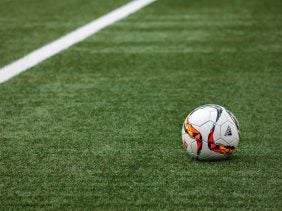Finding the right running shoe: Which shoe’s for you?
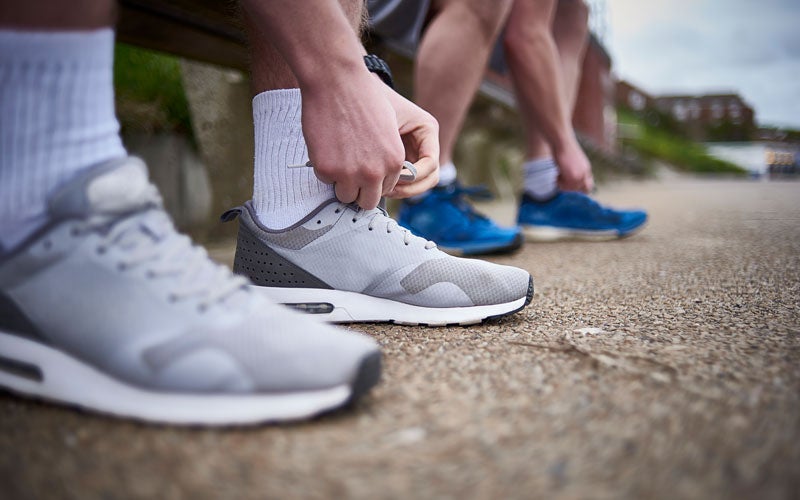 ©Jamie Garbutt
©Jamie Garbutt
Which running shoe is right for me? How should the perfect running shoe fit? And how do I find out which shoe is the perfect fit for my foot? Our article will give you an insight into the running shoe jungle.
Running is the universally most popular sport, and in Germany alone there are running events all year round with six-figure numbers of participants. The number of those who jog just for fun through streets, forests,and meadows is even greater. All runners are united by the same desire — finding the right running shoe.
It’s no surprise that running shoes are now available for every conceivable purpose and in all shapes and colors. It’s almost impossible to keep track of it all, especially online.
We’ll tell you why investing in good shoes is definitely worthwhile. And how you can find a shoe that’s perfect for you.
Our tip: Are you just starting to jog and don’t quite know which way is up and which way is down? In our overview article, you can find out everything you need to know about jogging.
Why do you need good running shoes?
Running is a monotonous activity that puts enormous strain on your posture and stability. Depending on your running speed, you need to be able to absorb 3 to 4 times your body weight with each step. For an average 10 km jog, you take about 9000 steps. So you can see how much work this means for your feet.

Good running shoes support our feet. They cushion the impact from running and support and guide our movement. The right material ensures our comfort.
Ill-fitting or inappropriate running shoes are not only uncomfortable, but also increase the risk of injury. In the best case they can cause blisters. In the worst case you may be setting yourself up for a stress fracture.
How expensive are good running shoes?
Most shoes from leading brands are priced between 100,- and 180,-. Their life expectancy depends on the type and quality of the shoe and therefore can vary. You can expect to run about 1000km in an average running shoe. If you regularly clock 20 kilometers a week, this amounts to a solid year of running.
Your feet are worth the price, especially considering that running is otherwise a cheap sport.
How should running shoes fit?
Basically, it’s quite simple: the right shoe for you is comfortable, doesn’t press or rub anywhere, and offers you stability and support without constricting you. In short: It feels as if it was made for your foot. So when trying on running shoes, pay attention to your foot and what feels most natural.
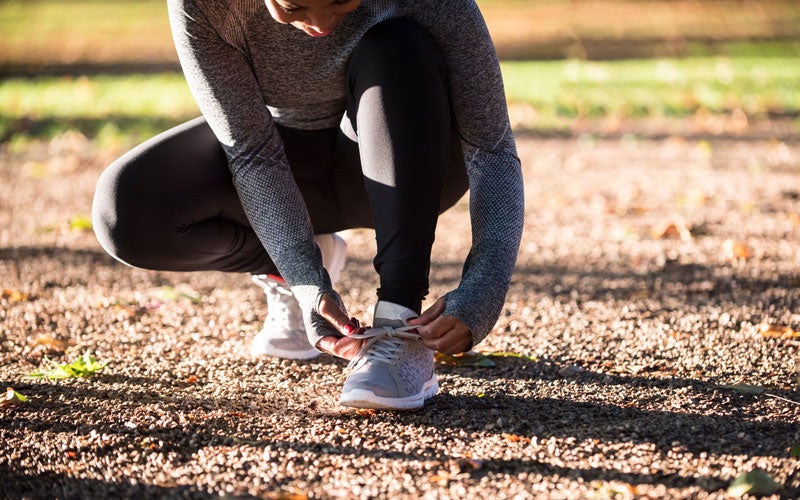
When testing potential running shoes, consider the following criteria:
- Is the shoe wide enough for your foot to rest comfortably on the entire inner sole?
- As a guideline, there should be a thumb’s width of space in the front end of the shoe when you’re standing. Your toes should also be almost at the edge of the shoe on either side, but still have some room.
- What is the fit in the middle of your foot like? The shoe should fit snugly here and provide support without pinching.
- What about the heel? Ideally, your sneaker should fit around your heel without any pressing or rubbing. You can find both sturdier and softer heel support. Try both and see what feels better.
- Also, your ankle should never roll to one side of the shoe but remain comfortably supported.
So everything fits and you’re ready to go? Great! Now it’s time to get your body in top shape. Try a refreshing glass of our Sparkling Aminos in summery peach flavor to give you the sustained energy you need for a good jog.
check out our sparkling aminos
The perfect running shoe: What’s the right size?
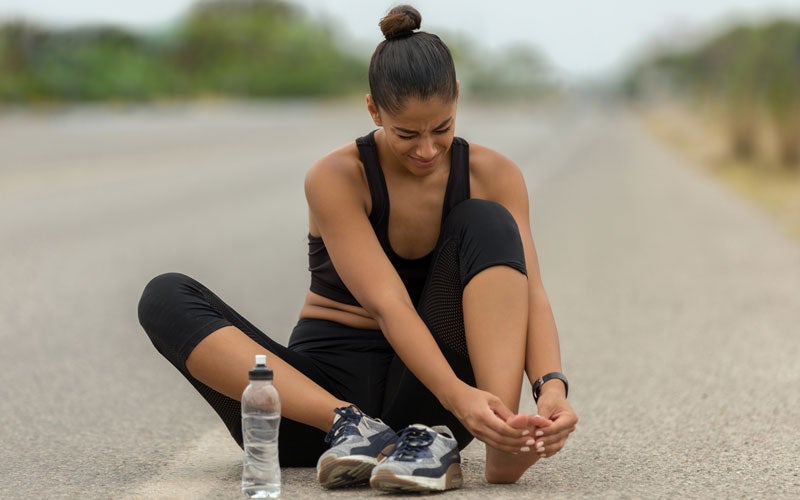
As a rule of thumb, your running shoes should be one size larger than your normal shoe size. Of course this depends on the manufacturer’s sizing.
Your foot gets tired when running. Your posture slackens and the arch of your foot sinks. As a result, the foot becomes slightly longer and wider. So, while your sneaker should fit well and provide support when you try it on and start running, it should not be too tight.
Therefore, you should always follow the “one-thumb width” rule. Make sure your thumb still fits between the end of your foot and the end of the shoe. If you have the feeling that you don’t have enough support and stability, then even the best running shoe is not the right type for you.
Three questions you should ask yourself before buying running shoes
Before you set about finding the best shoe for running, make sure you know exactly what you want your shoe to do. Ask yourself the following three questions.
1. Where do you want to go?
And more precisely: in which terrain? If you intend to run mostly on asphalt, running shoes with good cushioning are useful, depending on your weight, running speed and distance.
If you take your runs off-road, you will need a sole that has a better grip and provides support and stability in demanding terrain. Jogging over slippery rocks require a different sole than muddy trail running.
For a mix of road, forest, and field, there are ample all-round shoes that are very well suited as well.
2. What else must your shoe be able to do?
Do you want to walk to or from the office with your running shoe and not always have two pairs of shoes with you? Then buy running shoes that can sometimes match your work clothes.
3. Waterproof or breathable?
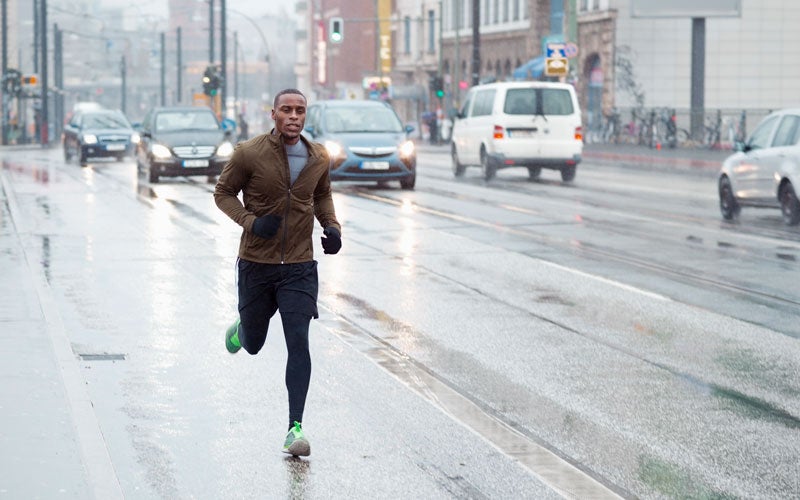
It’s an either/or. Water resistance always comes at the expense of breathability. Do you often run through morning dew, wet meadows, or even just the rain? Then a waterproof shell or at least a water-repellent exterior material is the best choice. Do your feet sweat a lot, and hey, it’s summer anyway? Then you should wear a breathable running shoe.
8 criteria to find the perfect running shoe
Finding your new running shoe is easier than it sounds. Our 8 criteria for the right running shoes help you choose which running shoes might suit you, whether you’re shopping online or in-store.
Even if office suitability is great, running shoes are only secondarily a fashion accessory. First and foremost, your new shoes should fit you and your foot. Start by applying these functional criteria before selecting your color.

First rule: Try it before you buy it. Personally evaluate all your potential fits.
If in doubt, ask an orthopedist to advise you on which the best type for you is. This is especially true if you know that you have a foot malposition, you roll your ankles, or you have orthopedic problems, such as knee or back pain.
1. Gender
Women usually have slightly narrower feet and shorter ankles than men with the same foot length [1] Manufacturers might label a shoe as a “women’s” or “men’s” shoe based on those measurements. So choose a shoe with that in mind.
2. Weight

There are different types of shoes for runners of different weights. Mostly these are divided into “light” “medium” and “heavy”. Frequently used categories are
light = less than 60kg
medium = 60-80kg
heavy = more than 80kg
3. Foot shape
The shape of your foot influences the way you move off of it. Foot shapes can be hereditary or caused by wearing the wrong shoes for a long time.
A flat or low arch can cause overpronation, i.e. the rolling of your foot over the inside of the foot.
A high arch, on the other hand, favors supination, i.e. the rolling of the foot over the outside of the foot. Since the metatarsal area of a high arch barely touches the ground, depending on the characteristics of the foot, running shoes with higher cushioning are usually recommended.
There are shoes with what is known as pronation or supination support, which is intended to either prevent or reduce the rolling movement. Even racing shoes often have curved soles, which are ideal for runners with supination. An alternative are custom-made orthopedic insoles and targeted training of the foot muscles.
Our tip: Check the sole of your old running shoes. If they are more worn on the outside or inside, this is an indication of either supination or pronation. If you don’t know how you move, please ask a specialist shop for a treadmill analysis of your gait and personalized advice from the salesperson.
If you have a normal foot, a plain shoe with a small difference in height between the toe and heel area is best.
4. Static leg axis
The static leg axis is about whether you have bow legs, knock-knees or a straight leg axis. This also influences the rolling movement of your foot and therefore plays a role when buying running shoes.
How to check your leg axis
An infographic showing three variations of knee alignment. The legs on the left show a healthy alignment. The knees in the middle are bow-legged, with the knees bending outwards. The legs on the right are knock-kneed, with the knees coming in too close to each other. Finding the right running shoe depends on getting one that supports your knee alignment properly.
Stand straight and relaxed in front of the mirror with your feet together. If you have a straight leg axis, your knees and ankles just about touch. If you also have a normal leg axis, a neutral running shoe is a good choice.
If you have knock-knees, your knees nearly touch while standing, while there’s a 2-3 finger width gap between your ankles. If you have bow legs, the opposite is true: there’s a 2-3 finger wide gap between your knees. For knock-knees, sturdy running shoes with pronation support or neutral shoes with orthopedic insoles are your best bet.
Bow legs favor supination. Therefore, you should have a treadmill analysis done and have shoes recommended that fit your running style.
Incidentally: Running is a skill that can be improved. The better your coordination skills as a runner, the more precise and economical your movement will be. Therefore, regularly include the running ABC in your runs.
5. Running style
Forefoot, midfoot, or heel first? The way your foot touches the ground when running is essential to decide what your new favorite shoes should look like. Forefoot runners should wear shoes with little cushioning (< 6 mm), for midfoot runners a 6 to 10 mm cushion will work.
If you land on your heel first, opinions are controversial. Basically, running shoes with a high cushion (>10mm) absorb the impact on the heel best. At the same time, however, they tempt you to continue running over the heel. In the long term, this puts a strain on the knee and spine.
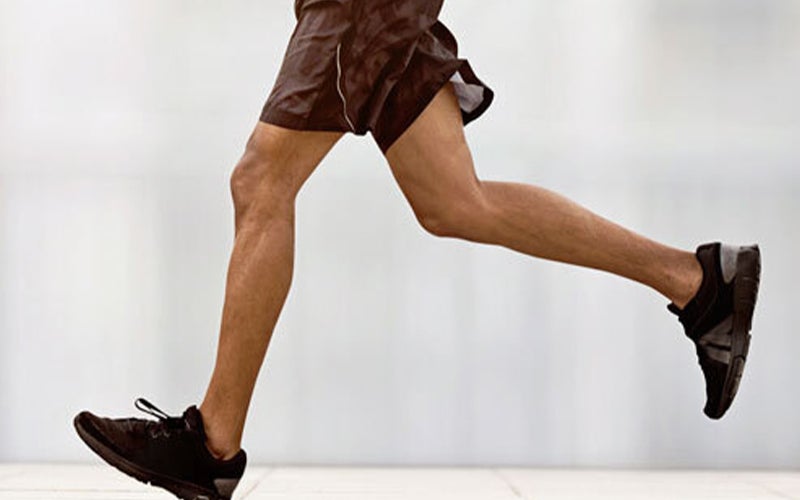
Our tip: Try to land on the middle or forefoot. It’s best to find an experienced personal trainer or running coach.
6. Running distance & speed
Do you want to run long and slow or short and fast? How many kilometers do you plan to get in each week? And on how many training sessions are these kilometers spread out? If you run more than 60 kilometers a week, you should be wearing two different pairs of shoes.
The more kilometers you run, the more cushioning is useful. For short – and perhaps faster – distances, a light running shoe can be a welcome change for your foot.
7. Timing your fitting
In the evening, your feet are a bit bigger and wider. This is partly due to potentially tired foot muscles after a long day, but also simply because of water retention that occurs during the day.
8. How it feels!
All theory aside, the most important thing is that your sneaker feels good. You’ll get a first impression when you try out running. But you will only know whether it fits properly after 1-2 longer runs.

What if you’ve already found the perfect running shoe that fits you? Then try its successor model or ask in a specialist shop for a similar shoe. Most salespeople know their product selection exactly and can recommend the best running shoe for you.
Anatomy not so much your thing? Ask for tips!
Foot shape, leg axis, core stability, running style and the resulting rolling motion are the most important anatomical parameters to consider when choosing the best running shoes for you. This all still seems a bit abstract to you? Then trust in a running shoe consultation from an expert in a specialist shop.
A running shoe analysis of your old shoes can also be informative. Take them with you when you go shopping.
Do you have knee or back pain that gets worse when you run? Then go see an orthopedist or sports physician to determine the cause before you continue running with other shoes.
Which running shoe is right for me?
Neutral shoe vs. stable shoe
Neutral running shoes are the best choice for straight leg axes and normal feet. Even if your shape deviates from the norm slightly, they may still fit you.
Overall, supportive running shoes offer stability, which is especially helpful if you roll your foot in (pronation) or out (supination). The downside of this support is its lack of flexibility: If you tend to roll your foot only slightly irregularly, that stability may be too strong.
Using orthopedic insoles in a neutral shoe is therefore typically better. Make sure you take the insoles with you when buying shoes.
On the other hand, there is still the question of the cause of your irregular movement. An untrained foot musculature is often the reason for a slight flat foot. The support also relieves some of the workload. In this case, you can help with targeted training of the foot muscles and you may be better advised to wear a neutral shoe.
Our tip: Do a treadmill analysis in a specialist shop. Most of the time, your gait behavior is taken into account when doing this. Some running shops as well as physiotherapists and sports physicians offer a more comprehensive analysis of your running style.
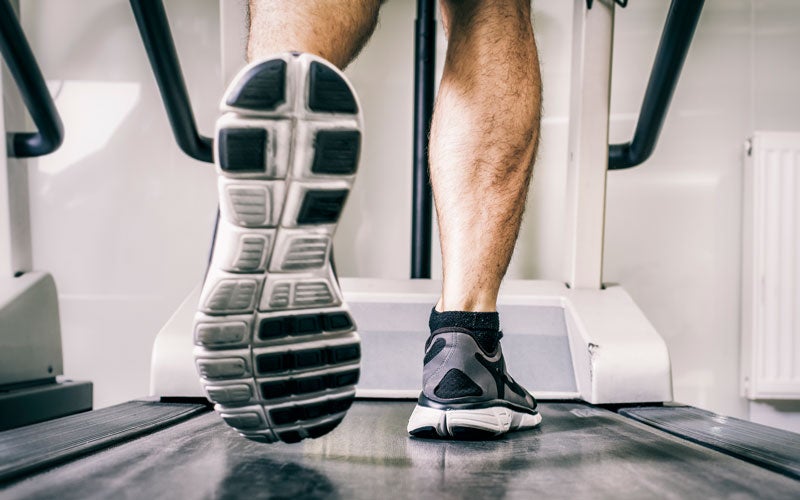
There you can find out whether the cause is perhaps muscular imbalances in your upper body, backside, or legs. You’ll also be given exercise recommendations that you can use to work on running healthier in the long term.
Especially if you are planning to run often or have back or knee pain, it’s better than buying simple running shoes.
Barefoot shoe vs. cushioning
Barefoot shoes are very trendy. Barefoot shoe fans swear that they allow a return to natural and healthy movement. And rightly so: After all, people were not born wearing shoes.
But: if you have been wearing shoes since your early childhood, your foot muscles are no longer used to running barefoot. Cushioned shoes are best for shock absorption and take some of the work off your muscles, while barefoot shoes make your feet do it all by themselves.
Sounds like good exercise? It is. But we recommend that you wear barefoot shoes for a short walk or regularly in the office first, to give your feet time to get used to the new strain. If you start running with barefoot shoes immediately, you run the risk of overuse injuries or even fatigue fractures.
Once they get used to that feel in everyday life, you can gradually start to run a few 100 meters in your barefoot shoes. And even if it feels great, give your feet time and opt for cushioned running shoes on occasion.
Training shoe vs. racing shoe
Training shoes offer more comfort and are designed for longer distances than competition shoes. Your foot benefits from more cushioning and support. If you like the lightness and minimalism of competition shoes, there are also lightweight options among the training shoes.
Competition shoes are minimalist, light, and breathable. They do without heavy materials and lots of cushioning. Having direct contact with the ground ensures optimal power, but is also more challenging for the foot.
Such light running shoes are especially for experienced runners with well-trained foot muscles. They are ideal for short, fast training sessions.
And by the way, if you just want to run a half marathon or a race just for fun, you can also do so in your normal favorite running shoe.
Find the perfect running shoe: Online vs. In-store Shopping
You see, finding the right running shoes is a complex issue. If you are new to the sport and are not 100% familiar with the characteristics of your feet and your running style, we definitely recommend a visit to a specialist shop.
The salespeople are usually well trained, know the fit of each model, and can suggest a few manufacturers and shoes that might be right for you. In a good store, your foot shape, leg axis, weight, and other factors are also taken into account. Make sure that the seller takes the time to do this.
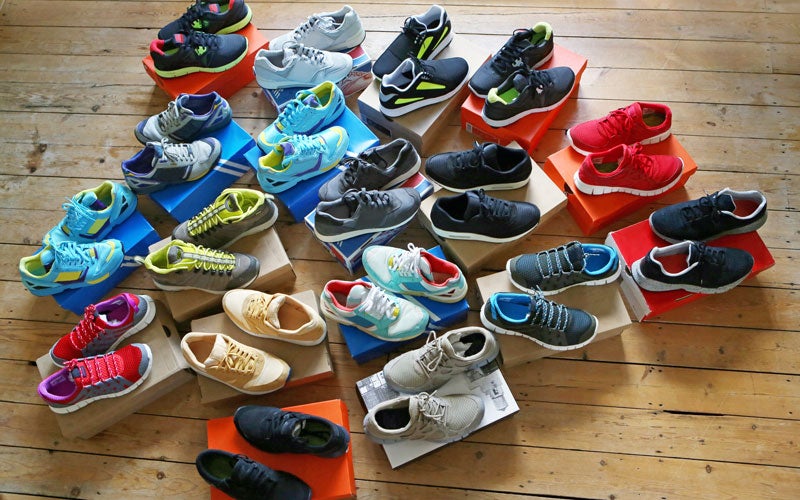
Take your old running shoes and fresh socks with you, ask yourself beforehand what you’re looking for, and preferably, go shopping towards the end of the day.
Buying running shoes online at a lower price is very tempting, but you should only do this if you already know which running shoes you are particularly comfortable with.
Use them as a guide and order a few different shoes, preferably in two sizes. Even follow-up models of your favorite shoes do not always turn out the same. Test run all shoes, ideally indoors, so that you can return them.
Check all the technical criteria for the right running shoe that you have learned here and listen to your gut feeling: you should feel super comfortable from the very first step.
Summary
- Determine the right running shoe for you by considering both your individual anatomical features and the purpose of the shoe.
- Running style, speed, and distance will determine what will be the perfect shoe for you.
- Running shoes should fit comfortably and as a rule of thumb be one size larger than your normal shoe size.
- If you are new to running, ask for guidance in a specialist shop.
- If you have orthopedic problems or pain, ask your orthopedist or sports physician for advice.
Sources for this article
We at foodspring use only high-quality sources, including peer-reviewed studies, to support the facts within our articles. Read our editorial policy to learn more about how we fact-check and keep our content accurate, reliable, and trustworthy.





























